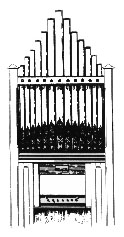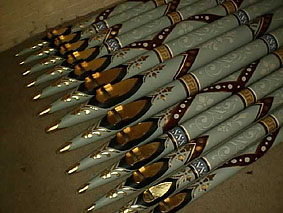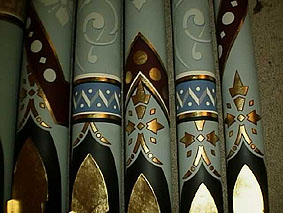
This organ is the third earliest Fincham instrument built for an Anglican church in Melbourne which still exists in a condition close to original. Indeed, only five earlier Fincham organs are known to survive in a reasonable state of originality.
|
The instrument was classified by the National Trust of Australia (Victoria) in 1992
because its preservation is considered to be essential to the heritage of Australia.
The citation reads as follows :
"A single-manual organ of six speaking stops built in 1871 by George Fincham ... it remains unaltered, retaining its original action, console, pipework and stencilled facade pipes."
The background colour of the facade pipes is a pale sage blue, over which a total of 24 stencilled patters have been employed. The specific colours employed include yellow ochre, raw sienna, deep red-brown, brick red, pale parchment blue, mid French blue, mid grey and plum burgundy.
The motifs include Florentine patterns, Grecian key patterns, medieval zig-zag and stylised fleur-de-lys. Many of the patterns have trompe l'oeuil shading, to give dimension and depth. Overall, the effect although rich, is muted and subtle and will blend admirably with the interior décor of St George's Church.
oooo§§oooo
Fincham was the most notable of 19th century colonial organ builders. He was born in London in 1828, and trained in his profession there. In 1852 he emigrated to Victoria, where he built more than 150 instruments before his death in 1910.
His works include the 1880 Grand Organ for the Exhibition Building, Melbourne, and the organs of St Patrick's Cathedral, the Freemasons' Hall, the Australian Church, St Kilda, and St Mary's Star-of-the-Sea, West Melbourne.
The instrument was built in 1871 for St Phillip's Church, Collingwood, and later
sold to St Saviour's Church, Collingwood. In 1957, it was restored and installed at
St George's, Bentleigh, and since then has undergone no further modification. When
St George's, Bentleigh, was deconsecrated and sold in September 1996, the instrument was
offered to the Parish of St George the Martyr, Queenscliff. It was welcomed with
much appreciation.
St George's Church is an appropriate new setting for the Fincham Organ, in terms of scale, acoustics, and historical context. One of the most beautifully decorated small churches in regional Victoria, St George's was listed by the National Trust in 1990.
In 1857 Bishop Perry licensed a timber building at Queenscliff to be used for public worship and as a school. In 1863 the present limestone church was built to a Medieval Gothic design by Melbourne architect, Albert Purchas. Opened in 1864, it was completed in 1878 with the addition of the stuccoed brick tower.
Extensions of the nave to create the present chancel were carried out in 1887 to the design of Purchas, and in 1953 a vestry was added as a memorial to Mrs Agnes Baillieu.
The interior has been divided into
nave and aisles by giant stuccoed arcading. The church is richly decorated with
fine stained glass and Minton encaustic floor tiles, and furnished with what appear to be
the original 'box' pews.
For a community with a resident population of only 3300, the Borough of Queenscliffe has a strong cultural life. In Queenscliff itself, book readings by prominent Australian writers take place frequently at the Queenscliff Hotel. There have been visits to the town by the Geelong Chamber Orchestra; theatrical and operatic performances by the Melbourne-based company, Period Pieces; Performances of The Magic Flute at Fort Queenscliff by Ozopera, the travelling company of Opera Australia; and most recently, a recital by the Cologne New Philharmonic Chamber Orchestra at the Church of St George the Martyr. The neighbouring town of Point Lonsdale has a long tradition of Sunday chamber orchestra and solo performances.
These activities are well supported by the resident community. Although this community is small, there is a high percentage of retired professional people actively pursuing cultural interests developed in their earlier city-based lives.
Over the last ten to fifteen years, however, musical, theatrical and literary events have been increasingly supported by visitors to the Borough, and there is clearly scope for growth in this area. The reasons are not difficult to see, given the close proximity of the Borough to the major population centres of Melbourne and Geelong, its excellent accommodation and dining facilities, and Queenscliff's heritage ambience. Queenscliff has benefited from the growing number of double-income families with the financial means to travel, but who, because of work commitments, tend to take shorter, more frequent breaks, relatively close to home. This trend is reflected in accommodation patterns. In 1996, 19,283 person-arrivals and 31,041 person-nights were logged by hotel, motel, and guesthouse proprietors, 86% of visitors being from within Victoria. This pattern, the trend for satisfying nostalgia and the search for national heritage have fuelled considerable growth in 'cultural' visits to the Borough.
Increased musical activity in the
Borough, therefore, can translate fairly directly into economic improvement and
employment. With these benefits in mind, members of the local community are engaged
in organising a regular music festival in Queenscliff, to be held in November each year.
The Church of St George the Martyr would like to play an important part in the musical life of Queenscliff. Members of the Church were closely involved in local preparations for the Ozopera performances, at the time mounting an exhibition of operatic set designs in the historic Church Hall. One of the finest parish churches in this part of Australia, St George the Martyr has been listed with the local tourism authority (Geelong Otway Tourism), and has hosted the Cologne New Philharmonic Chamber Orchestra for the past three years as part of an on-going arrangement.
|
Installation of the
Fincham organ would permit the development of a series of organ recitals, which could be
organised in collaboration with accommodation houses.




